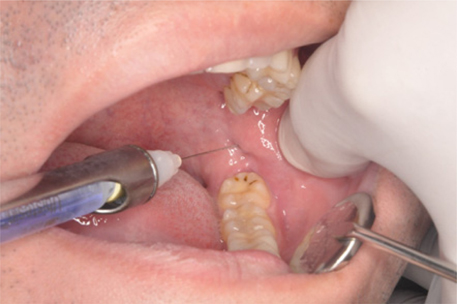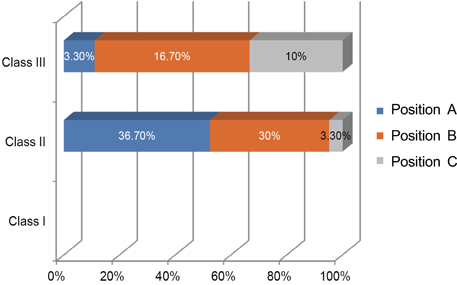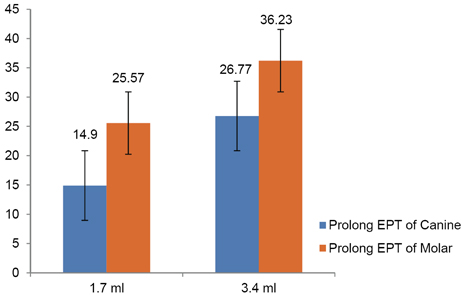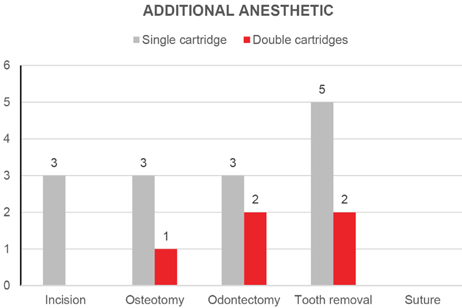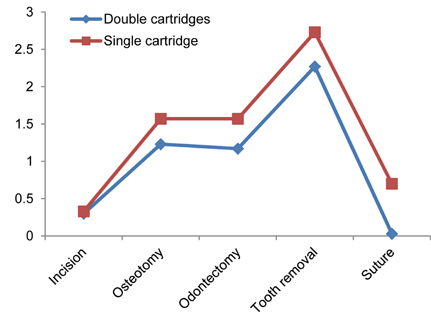J Dent Anesth Pain Med.
2017 Jun;17(2):121-127. 10.17245/jdapm.2017.17.2.121.
Double versus single cartridge of 4% articaine infiltration into the retro-molar area for lower third molar surgery
- Affiliations
-
- 1Department of Oral & Maxillofacial Surgery, Faculty of Dentistry, Mahidol University, Bangkok, Thailand. natthamet.won@mahidol.ac.th
- KMID: 2384473
- DOI: http://doi.org/10.17245/jdapm.2017.17.2.121
Abstract
- BACKGROUND
There are no studies regarding 4% articaine infiltration injection into the retro-molar area for an impacted lower third molar (LITM) surgery. This study aimed to evaluate the efficacy of infiltration using 1.7 ml (single cartridge: SC) of 4% articaine versus 3.4 ml (double cartridges: DC) of 4% articaine with 1:100,000 epinephrine in LITM surgery. METHOD: This study involved 30 healthy patients with symmetrical LITM. The patients were assigned to receive either a DC or SC of 4% articaine with 1:100,000 epinephrine as a local anesthetic for each operation. Onset, duration, profoundness, need for additional anesthetic administration, total volume of anesthetic used, vitality of the tooth, and pain score during operation were recorded.
RESULTS
The DC of 4 % articaine had a significantly higher success rate (83.3%) than did the SC (53.3%; P < 0.05). The duration of soft tissue anesthesia was longer in the DC group. The intra-operative pain was higher in the SC group with a significant (P < 0.05) requirement for a supplementary local anesthetic.
CONCLUSION
We concluded that using DC for the infiltration injection had a higher success rate, longer duration of anesthesia, less intra-operative pain, and a lower amount of additional anesthesia than SC in the surgical removal of LITM. We recommend that a DC of 4% articaine and a 1:100,000 epinephrine infiltration in the retro-molar region can be an alternative anesthetic for LITM surgery.
Keyword
MeSH Terms
Figure
Reference
-
1. Harn SD, Durham TM. Incidence of lingual nerve trauma and postinjection complications in conventional mandibular block anesthesia. J Am Dent Assoc. 1990; 121:519–523.
Article2. Pogrel MA. Permanent nerve damage from inferior alveolar nerve block - An update to include articaine. J Calif Dent Assoc. 2007; 35:271–273.3. Smith MH. Nerve injuries after dental injection: A Review of the Literature. J Can Dent Assoc. 2006; 72:559–564.4. Gazal G, Alharbi AM, Al-Samadani KH, Kanaa MD. Articaine and mepivacaine buccal infiltration in securing mandibular first molar pulp anesthesia following mepivacaine inferior alveolar nerve block: A randomized, double-blind crossover study. Saudi J Anaesth. 2015; 9:397–403.
Article5. Matthews R, Drum M, Reader A, Nusstein J, Beck M. Articaine for supplemental buccal mandibular infiltration anesthesia in patients with irreversible pulpitis when the inferior alveolar nerve block fails. J Endod. 2009; 35:343–346.
Article6. Subbiya A, Pradeepkumar AR, Vivekanandhan P, Karthick A. Comparative efficacy evaluation of articaine as buccal infiltration and lignocaine as IANB in the mandibular first molar with irreversible pulpitis. Indian J Multidiscip Dent. 2011; 2:370–373.7. Zain M, Rehman Khattak SU, Sikandar H, Shah SA, Fayyaz . Comparison of anaesthetic efficacy of 4% articaine primary buccal infiltration versus 2% lidocaine inferior alveolar nerve block in symptomatic mandibular first molar teeth. J Coll Physicians Surg Pak. 2016; 26:4–8.8. El-Kholey KE. Infiltration anesthesia for extraction of the mandibular molars. J Oral Maxillofac Surg. 2013; 71:1658.e1–1658.e5.
Article9. Lima-Júnior JL, Dias-Ribeiro E, de Araújo TN, Ferreira-Rocha J, Honfi-Júnior ES, Sarmento CF, et al. Evaluation of the buccal vestibule- palatal diffusion of 4% articaine hydrochloride in impacted maxillary third molar extractions. Med Oral Patol Oral Cir Bucal. 2009; 14:E129–E132.10. Kanaa MD, Whitworth JM, Corbett IP, Meechan JG. Articaine and lidocaine mandibular buccal infiltration anesthesia: a prospective randomized double-blind cross-over study. J Endod. 2006; 32:296–298.
Article11. Fowler S, Drum M, Reader A, Beck M. Anesthetic success of an inferior alveolar nerve block and supplemental articaine buccal infiltration for molars and premolars in patients with symptomatic irreversible pulpitis. J Endod. 2016; 42:390–392.
Article12. Abazarpoor R, Parirokh M, Nakhaee N, Abbott PV. Comparison of different volumes of articaine for inferior alveolar nerve block for molar teeth with symptomatic irreversible pulpitis. J Endod. 2015; 41:1408–1411.
Article13. Malamed SF. Handbook of Local Anesthetisia. sixth edition ed. St. Louis, Missouri: Mosby;2014. p. 225–252.14. Meechan JG. The use of the mandibular infiltration anesthetic technique in adults. J Am Dent Assoc. 2011; 142:19S–24S.
Article15. Snoeck M. Articaine: a review of its use for local and regional anesthesia. Local Reg Anesth. 2012; 5:23–33.
Article16. Senes AM, Calvo AM, Colombini-Ishikiriama BL, Gonçalves PZ, Dionísio TJ, Sant'ana E, et al. Efficacy and safety of 2% and 4% articaine for lower third molar surgery. J Dent Res. 2015; 94:166S–173S.
Article17. Martin M, Nusstein J, Drum M, Reader A, Beck M. Anesthetic efficacy of 1.8 mL versus 3.6 mL of 4% articaine with 1:100,000 epinephrine as a primary buccal infiltration of the mandibular first molar. J Endod. 2011; 37:588–592.
Article18. Becker DE, Reed KL. Local anesthetics: review of pharmacological considerations. Anesth Prog. 2012; 59:90–102. quiz 102-3.
Article19. Lasemi E, Sezavar M, Habibi L, Hemmat S, Sarkarat F, Nematollahi Z. Articaine (4%) with epinephrine (1:100,000 or 1:200,000) in inferior alveolar nerve block: Effects on the vital signs and onset, and duration of anesthesia. J Dent Anesth Pain Med. 2015; 15:201–205.
Article20. Sreekumar K, Bhargava D. Comparison of onset and duration of action of soft tissue and pulpal anesthesia with three volumes of 4% articaine with 1:100,000 epinephrine in maxillary infiltration anesthesia. Oral Maxillofac Surg. 2011; 15:195–199.
Article21. Boonsiriseth K, Chaimanakarn S, Chewpreecha P, Nonpassopon N, Khanijou M, Ping B, et al. 4% lidocaine versus 4% articaine for inferior alveolar nerve block in impacted lower third molar surgery. J Dent Anesth Pain Med. 2017; 17:29–35.
Article22. Epstein S. Pressure injection of local anesthetics: clinical evaluation of an instrument. J Am Dent Assoc. 1971; 82:374–377.
Article
- Full Text Links
- Actions
-
Cited
- CITED
-
- Close
- Share
- Similar articles
-
- The anesthetic efficiency of retromolar infiltrations with two local anesthetic solutions of the same concentration in lower third molar surgery
- Anesthetic efficacy of buffered 4% articaine for mandibular first molar infiltration: a crossover clinical trial
- Single buccal infiltration of high concentration lignocaine versus articaine in maxillary third molar surgery
- Comparison of lidocaine with articaine buccal injection in reducing complications following impacted mandibular third molar surgery: a split-mouth randomized clinical trial
- Buffered articaine infiltration for primary maxillary molar extractions: a randomized controlled study

